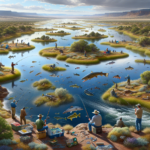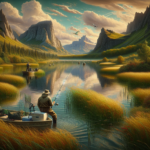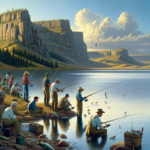Fishing in New Mexico: Lakes, Rivers, and Reservoirs

Introduction
Did you know that New Mexico is home to over 200 public fishing waters, including lakes, rivers, and reservoirs? This southwestern state offers a diverse range of fishing opportunities that cater to both novice and experienced anglers. In this article, we will explore the best fishing spots in New Mexico, the techniques you need to master, the species you can expect to catch, and much more. Whether you’re planning a fishing trip or looking to improve your skills, this guide has you covered.
Fishing in New Mexico matters because it provides not only a recreational activity but also a way to connect with nature and contribute to local conservation efforts. Understanding the best spots, techniques, and regulations can enhance your fishing experience and ensure sustainable practices.
Background/Context
Historical or Cultural Significance
Fishing has been an integral part of New Mexico’s history and culture for centuries. Indigenous tribes, such as the Pueblo and Navajo, have relied on the state’s rivers and lakes for sustenance. Today, fishing remains a popular pastime, contributing to the state’s tourism and local economies.
Geographical Overview
New Mexico’s diverse geography includes high desert plains, rugged mountains, and lush river valleys. The state’s climate varies from arid in the south to alpine in the north, providing a range of fishing environments. Key water bodies include the Rio Grande, Pecos River, and Elephant Butte Reservoir, each offering unique fishing experiences.
Key Points/Details
Fishing Techniques
Technique Overview
New Mexico offers a variety of fishing techniques, including fly fishing, spin fishing, and baitcasting. Fly fishing is particularly popular in the state’s rivers and streams, while spin fishing and baitcasting are commonly used in lakes and reservoirs.
When and Where to Use
Fly fishing is best suited for the Rio Grande and Pecos River, especially during the spring and fall when insect hatches are abundant. Spin fishing and baitcasting are ideal for larger bodies of water like Elephant Butte Reservoir and Navajo Lake, particularly in the summer months.
Recommended Gear
- Fly Fishing: 5-6 weight rods, floating lines, and a variety of dry flies, nymphs, and streamers.
- Spin Fishing: Medium action rods, spinning reels, and a selection of spinners, crankbaits, and soft plastics.
- Baitcasting: Heavy action rods, baitcasting reels, and lures such as jigs, swimbaits, and topwater plugs.
Species Information
Species Overview
New Mexico’s waters are home to a variety of fish species, including rainbow trout, brown trout, largemouth bass, smallmouth bass, and catfish. Each species has its own habits and preferred habitats.
Best Practices
For trout, focus on cold, clear streams and rivers with plenty of cover. Use small, natural-looking flies or lures. For bass, target warmer waters with structures like submerged logs or rock formations. Use larger, more aggressive lures.
Location Information
Top Fishing Spots
- Rio Grande: Known for its excellent trout fishing, especially in the Taos area.
- Pecos River: Offers both trout and bass fishing, with easy access points and beautiful scenery.
- Elephant Butte Reservoir: One of the largest bodies of water in the state, ideal for bass, catfish, and crappie.
- Navajo Lake: A prime spot for bass and trout, with numerous amenities and boat access.
Regulations and Licenses
Fishing in New Mexico requires a valid fishing license, which can be purchased online or at local retailers. Regulations vary by water body and species, so it’s essential to check the New Mexico Department of Game and Fish website for the latest rules and catch limits.
Seasonal Considerations
Seasonal Variations
Fishing conditions in New Mexico change throughout the year. Spring and fall are ideal for trout fishing, while summer is best for bass and catfish. Winter can be challenging due to cold temperatures, but ice fishing is possible in some northern lakes.
Best Times to Fish
The optimal times to fish are early morning and late evening when fish are most active. Seasonal peaks include spring for trout and summer for bass and catfish.
Events and Tournaments
Event Overview
New Mexico hosts several fishing events and tournaments throughout the year, such as the Elephant Butte Bass Tournament and the Pecos River Fly Fishing Challenge. These events offer opportunities to compete, learn, and connect with other anglers.
Preparation Tips
To prepare for a tournament, practice your techniques, familiarize yourself with the fishing area, and ensure your gear is in top condition. Consider pre-fishing the location to identify the best spots and strategies.
Tips and Best Practices
General Tips
- Always check local regulations before fishing.
- Use the right gear for the species and location.
- Practice catch and release to support conservation efforts.
Avoid Common Mistakes
- Not checking weather conditions before heading out.
- Using the wrong type of bait or lures for the target species.
- Ignoring local fishing regulations and catch limits.
Advanced Techniques
- Mastering the double haul cast for fly fishing.
- Using electronics like fish finders to locate fish in larger bodies of water.
- Employing advanced knot-tying techniques for stronger, more reliable connections.
Gear and Equipment Recommendations
Essential Gear
- Fishing rod and reel appropriate for your chosen technique.
- Selection of lures, flies, or bait.
- Fishing line suited to the species and conditions.
- Tackle box with essential tools like pliers, line cutters, and extra hooks.
Optional Gear/Upgrades
- Waders for river and stream fishing.
- Fish finder for larger lakes and reservoirs.
- High-quality polarized sunglasses to reduce glare and see fish more clearly.
Where to Buy or Rent
Local shops like Los Pinos Fly & Tackle Shop in Albuquerque and online retailers such as Bass Pro Shops and Cabela’s offer a wide range of fishing gear. Some locations also offer rental options for larger equipment like boats and fish finders.
Safety and Conservation
Safety Tips
- Always wear a life jacket when fishing from a boat.
- Be aware of weather conditions and avoid fishing during storms.
- Carry a first aid kit and know basic first aid procedures.
Conservation Practices
- Practice catch and release to help maintain fish populations.
- Respect local wildlife and habitats by minimizing your impact.
- Follow all fishing regulations and report any violations to authorities.
Planning Your Trip
Accommodations
New Mexico offers a range of accommodations near popular fishing spots, from campgrounds and RV parks to hotels and lodges. For example, Elephant Butte Lake State Park has several campgrounds, while the town of Taos offers various lodging options near the Rio Grande.
Travel Tips
When planning your trip, consider the best routes to your fishing destination. Major highways like I-25 and I-40 provide easy access to many fishing spots. Ensure your vehicle is equipped for the terrain, especially if you’re heading to remote areas.
Additional Activities
New Mexico is rich in outdoor activities beyond fishing. Hiking, bird watching, and exploring historical sites can make your trip more enjoyable for non-anglers in your group. Popular attractions include Carlsbad Caverns National Park and the historic town of Santa Fe.
Frequently Asked Questions (FAQs)
Do I need a fishing license in New Mexico?
Yes, a valid fishing license is required for anyone aged 12 and older. Licenses can be purchased online or at local retailers.
What are the best times of year to fish in New Mexico?
Spring and fall are ideal for trout fishing, while summer is best for bass and catfish. Early morning and late evening are generally the best times of day to fish.
Can I fish year-round in New Mexico?
Yes, many of New Mexico’s waters are open for fishing year-round, but some areas may have seasonal restrictions. Always check local regulations before heading out.
What types of fish can I catch in New Mexico?
Common species include rainbow trout, brown trout, largemouth bass, smallmouth bass, and catfish. Each species has its own preferred habitats and seasons.
Conclusion
Fishing in New Mexico offers a diverse and rewarding experience for anglers of all skill levels. From the pristine rivers and streams to the expansive lakes and reservoirs, there’s something for everyone. By understanding the best techniques, species, and locations, you can make the most of your fishing adventures in this beautiful state. So grab your gear, check the regulations, and head out to explore the rich fishing opportunities that New Mexico has to offer.
Whether you’re a seasoned angler or a beginner, this guide provides the information you need to enhance your fishing experience. Happy fishing!




